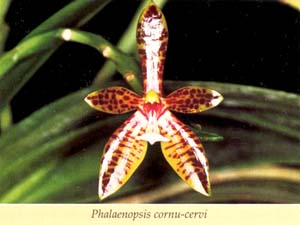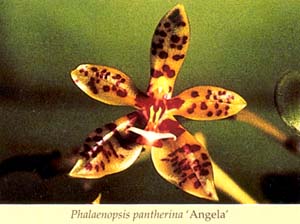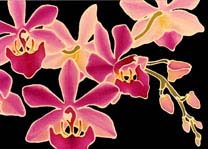Hybridizing with Phalaenopsis Species
by Bill Livingston
Phalaenopsis cornu-cervi
|
Phalaenopsis cornu-cervi has several forms; the flower from Borneo is about 1.5 inches in size, while the picta form from India is about one inch in size. This species is distinguished by its rather plump, flattened inflorescence from which flowers with small petals emerge. The plant flowers almost continuously, and as older flowers fade, new flowers appear. Primary hybrids made with this species have been used to improve and give color to other generations of hybrids. I once saw a very dark green P. cornu-cervi flower which was almost an emerald color, and I have never seen one like it since. The most common color is yellowish green, and its markings are some variation of reddish brown or cinnamon colored bars, spots and blotches over all segments. The lip is white or near-white with parallel, reddish brown or cinnamon colored stripes on the lateral lobes and base of the column. Breeding this species with standard whites results in shades of chartreuse as well as some desert colors. Phalaenopsis cornu-cervi has a flat, star-shaped flower with petals relatively small for the size of the flower, and its hybrid flowers are generally of poor shape, probably because the pollen parent was not the best choice for hybridizing. When hybridized with P. lueddemanniana or P. violacea, progeny can include chocolate-red colors.
|


|



This article which has been reprinted here with permission, originally appeared in the Volume 66, Number 4 edition of Orchid Digest, (Oct-Dec 2002), which is a Special Edition that highlights Phalaenopsis, and also features an excellent article on Phal culture by the Tuskes. The Phalaenopsis Special Edition of Orchid Digest can be ordered from Orchid Digest for $22. Highly recommended.
This article, all of its sections and accompanying photographs
are copyright 2002 by Orchid Digest Corporation.
Note: This site uses Javascript Navigation Controls;
if you have Javascript disabled on your Browser,
you will need to use the Site Map to navigate this site.
|



